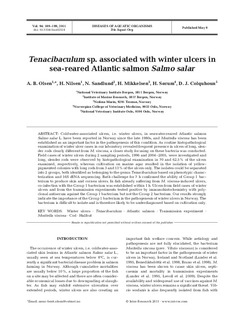Tenacibaculum sp. associated with winter ulcers in sea-reared Atlantic salmon Salmo salar
Journal article, Peer reviewed
Permanent lenke
http://hdl.handle.net/11250/117158Utgivelsesdato
2011-05-09Metadata
Vis full innførselSamlinger
Originalversjon
http://dx.doi.org/10.3354/dao02324Sammendrag
Coldwater-associated ulcers, i.e. winter ulcers, in seawater-reared Atlantic salmon
Salmo salar L. have been reported in Norway since the late 1980s, and Moritella viscosa has been
established as an important factor in the pathogenesis of this condition. As routine histopathological
examination of winter ulcer cases in our laboratory revealed frequent presence in ulcers of long, slender
rods clearly different from M. viscosa, a closer study focusing on these bacteria was conducted.
Field cases of winter ulcers during 2 sampling periods, 1996 and 2004–2005, were investigated and
long, slender rods were observed by histopathological examination in 70 and 62.5% of the ulcers
examined, respectively, whereas cultivation on marine agar resulted in the isolation of yellowpigmented
colonies with long rods from 3 and 13% of the ulcers only. The isolates could be separated
into 2 groups, both identified as belonging to the genus Tenacibaculum based on phenotypic characterization
and 16S rRNA sequencing. Bath challenge for 7 h confirmed the ability of Group 1 bacterium
to produce skin and cornea ulcers. In fish already suffering from M. viscosa-induced ulcers,
co-infection with the Group 1 bacterium was established within 1 h. Ulcers from field cases of winter
ulcers and from the transmission experiments tested positive by immunohistochemistry with polyclonal
antiserum against the Group 1 bacterium but not the Group 2 bacterium. Our results strongly
indicate the importance of the Group 1 bacterium in the pathogenesis of winter ulcers in Norway. The
bacterium is difficult to isolate and is therefore likely to be underdiagnosed based on cultivation only.
